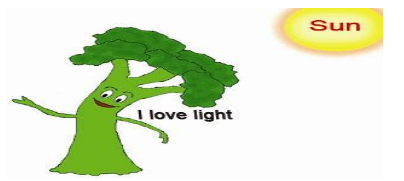
Movement Due To Growth
Control And Coordination of Class 10
Response of a plant to any external stimuli is done by occurrence of directional movements .
As can be seen in case of tendrils of pea plants in which the tendrils coil around any support in their way to climb up. Mechanism involved in this includes more rapid growth in area not in contact with the support as compare to area of tendrils in contact thus helping tendrils to coil around the support.
Plant movement can also be divided into two heads on the basis of direction :
- Tropism or Tropic movement
- Nasties or Nastic movement
Tropism:
Growth movements which occur in response to unidirectional external stimuli and result in positioning of the plant part in the direction of stimulus, are described as tropic movements. Here the stimulus acts on the protoplasm from one side. The response of an organism in the direction of a stimulus or away from it is called tropic movement or tropism. A tropic movement may be positive or negative (towards or away from the source of stimulus). The plant may respond by growth or turgor changes, so that parts of the plant bend towards or away from the direction of stimulus. Tropic movements are of various types, in response to different stimuli.
Types of Tropism: Depending upon the type of stimuli, different types of tropism are classified. There are five types of well recognized stimuli studied and tropisms are also studied in response to them. They are
- Light
- Chemicals
- Water
- Gravity
- Touch
Similarly, the types of tropisms are
|
Phototropism |
In response to light |
|
Chemotropism |
In response to chemical |
|
Hydrotropism |
In response to water |
|
Geotropism |
In response to gravity |
|
Thigmotropism |
In response to touch |
Phototropism: It is directional growth in which the direction of growth is determined by the direction of the light source. In other words, it is the growth and response to a light stimulus. Phototropism is most often observed in plants, but can also occur in other organisms such asfungi. The cells on the plant that are farthest from the light have a chemical called auxin that reacts when phototropism occurs. This causes the plant to haveelongated cellson the farthest side from the light. Phototropism is one of the many planttropismsor movements which respond to external stimuli. Growth towards a light source is apositive phototropism, while growth away from light is callednegative phototropism(orSkototropism).
For example, stem / shoot shows movement towards the light, which means shoot shows positive phototropism. Root shows movement away from the light i.e. negative phototropism.
Important point about Phototropism
- Movement of plant in response to light is called phototropism.
- The stem grows towards the source of light, hence called as positively phototropic.
- The root, on the other hand, grows away from the source of light, hence described as negatively phototropic.
- The leaves of many plants grow at right angles to the incident light, hence they are called as diaphototropic. Positive phototropism can be demonstrated by growing a potted plant in a heliotropic chamber.

Phototropism in Plants









